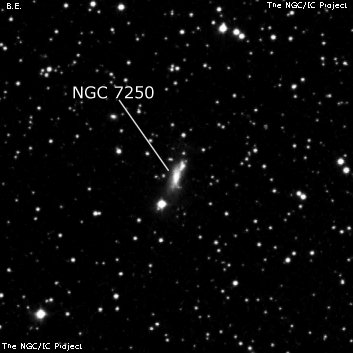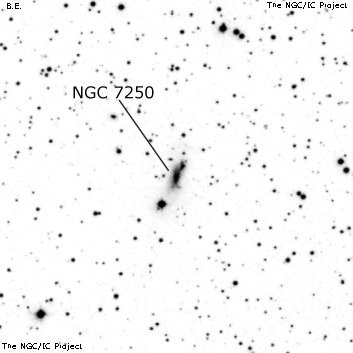NGC/IC Project Restoration Effort
(This is a very very beta version)
NGC7250


Basic Information
Location and Magnitude
Right Ascension: 22:18:17.7
Declination: +40:33:47
Constellation: LAC
Visual Magnitude: 12.6
Historic Information
Discoverer: Herschel W.
Year of discovery: 1790
Discovery aperture: 18.7
Observational
Summary description: vF, S, mE 165° ±
Sub-type: Sd
Steve's Notes
=====
NGC 7250
24" (9/2/16): at 200x; this disrupted galaxy or interacting pair appeared moderately bright, elongated 5:2 N-S, 0.7'x0.3', bright core. A small, very faint knot or extension is at the north end. A mag 10.9 star is 0.9' SE of center. At 375x; the "knot" attached on the west side of north end of the galaxy extends ~20"x10" NNW-SSE (slightly different PA than the main galaxy), increasing the total size of the merged glow to nearly 1.0'x0.3'. HyperLeda catalogues the object at the north end as a galaxy (PGC 214816), though on the SDSS it appears to be a collection of blue knots. NGC 7248 is 17' WSW.
24" (8/7/13): moderately bright, fairly small, elongated 5:2 N-S, 0.75'x0.3', sharply concentrated with a very small brighter nucleus. A mag 11 star is just off the SSE edge. The structure at the north end was masked by Type-Ia supernova 2013dy at mag 13-13.5, which was discovered on July 10th, a couple of weeks before maximum. The supernova was 2" W and 25" N of the nucleus of NGC 7250.
18" (10/19/06): fairly faint, fairly small, very elongated NNW-SSE, 0.6'x0.2', very small bright core. A mag 11 star is just off the SSE end. The galaxy fades at the tips, so the full extent was difficult to determine but appears to extend to 1.0'x0.25'. A very faint knot (PGC 214816) is occasionally visible at the NNW end. This nearly stellar "knot" is often noted as an interacting companion, though it may be a bright HII complex in the galaxy. NGC 7250 is classified as a starburst galaxy.
13.1" (8/24/84): fairly faint, very elongated streak NNW-SSE, small bright core. A mag 11 star is off the SSE tip 0.9' from center. Pair with NGC 7248 17' WSW. This galaxy may be an interacting double system but it was not resolved.



